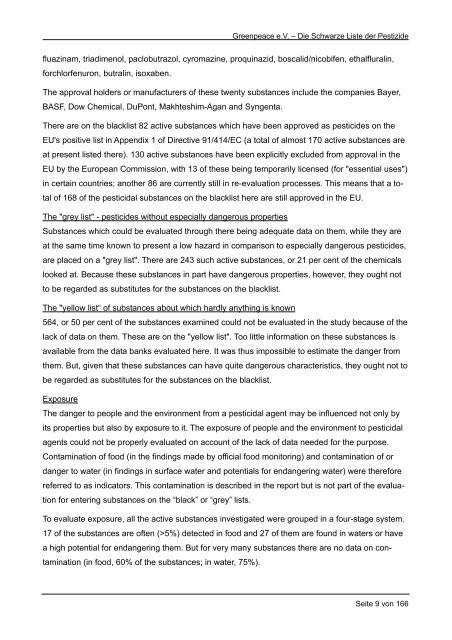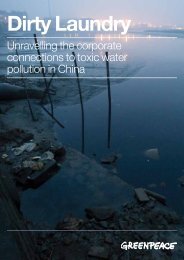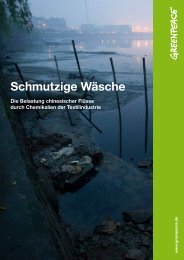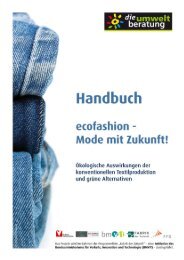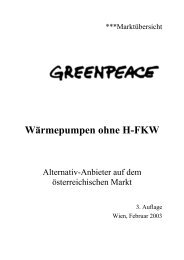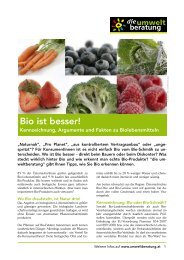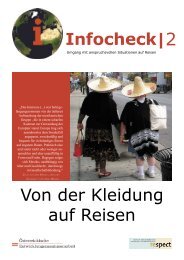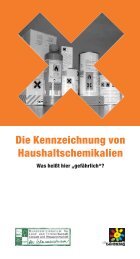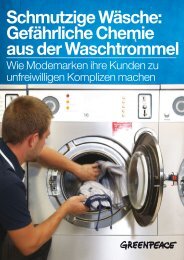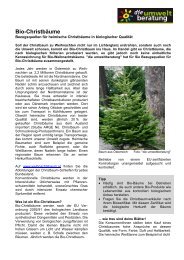Die Schwarze Liste der Pestizide - Greenpeace
Die Schwarze Liste der Pestizide - Greenpeace
Die Schwarze Liste der Pestizide - Greenpeace
Erfolgreiche ePaper selbst erstellen
Machen Sie aus Ihren PDF Publikationen ein blätterbares Flipbook mit unserer einzigartigen Google optimierten e-Paper Software.
<strong>Greenpeace</strong> e.V. – <strong>Die</strong> <strong>Schwarze</strong> <strong>Liste</strong> <strong>der</strong> <strong>Pestizide</strong><br />
fluazinam, triadimenol, paclobutrazol, cyromazine, proquinazid, boscalid/nicobifen, ethalfluralin,<br />
forchlorfenuron, butralin, isoxaben.<br />
The approval hol<strong>der</strong>s or manufacturers of these twenty substances include the companies Bayer,<br />
BASF, Dow Chemical, DuPont, Makhteshim-Agan and Syngenta.<br />
There are on the blacklist 82 active substances which have been approved as pesticides on the<br />
EU's positive list in Appendix 1 of Directive 91/414/EC (a total of almost 170 active substances are<br />
at present listed there). 130 active substances have been explicitly excluded from approval in the<br />
EU by the European Commission, with 13 of these being temporarily licensed (for "essential uses")<br />
in certain countries; another 86 are currently still in re-evaluation processes. This means that a total<br />
of 168 of the pesticidal substances on the blacklist here are still approved in the EU.<br />
The "grey list" - pesticides without especially dangerous properties<br />
Substances which could be evaluated through there being adequate data on them, while they are<br />
at the same time known to present a low hazard in comparison to especially dangerous pesticides,<br />
are placed on a "grey list". There are 243 such active substances, or 21 per cent of the chemicals<br />
looked at. Because these substances in part have dangerous properties, however, they ought not<br />
to be regarded as substitutes for the substances on the blacklist.<br />
The "yellow list“ of substances about which hardly anything is known<br />
564, or 50 per cent of the substances examined could not be evaluated in the study because of the<br />
lack of data on them. These are on the "yellow list". Too little information on these substances is<br />
available from the data banks evaluated here. It was thus impossible to estimate the danger from<br />
them. But, given that these substances can have quite dangerous characteristics, they ought not to<br />
be regarded as substitutes for the substances on the blacklist.<br />
Exposure<br />
The danger to people and the environment from a pesticidal agent may be influenced not only by<br />
its properties but also by exposure to it. The exposure of people and the environment to pesticidal<br />
agents could not be properly evaluated on account of the lack of data needed for the purpose.<br />
Contamination of food (in the findings made by official food monitoring) and contamination of or<br />
danger to water (in findings in surface water and potentials for endangering water) were therefore<br />
referred to as indicators. This contamination is described in the report but is not part of the evaluation<br />
for entering substances on the “black” or “grey” lists.<br />
To evaluate exposure, all the active substances investigated were grouped in a four-stage system.<br />
17 of the substances are often (>5%) detected in food and 27 of them are found in waters or have<br />
a high potential for endangering them. But for very many substances there are no data on contamination<br />
(in food, 60% of the substances; in water, 75%).<br />
Seite 9 von 166


